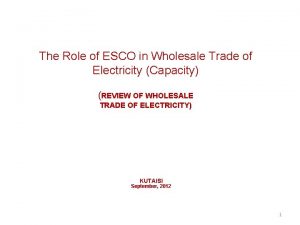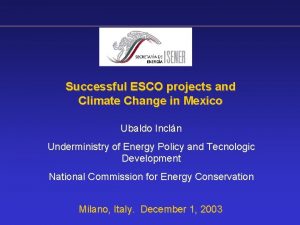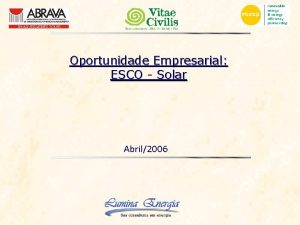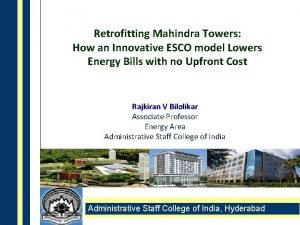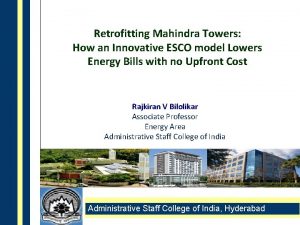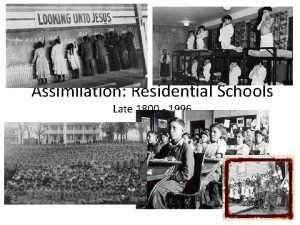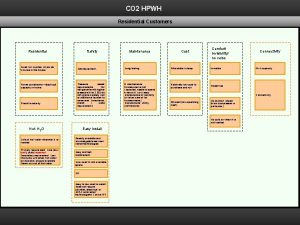Using the ESCO model for the residential sector









































- Slides: 41

Using the ESCO model for the residential sector: challenges and barriers Vlasta Zanki, Ph. D 18. 10. 2017. Varese, Italy 7. 11. 2017. Bratislava, Slovakia

SUMMARY • • • HEP ESCO background and experience Why ESCO project in residential sector? Regulatory framework Barriers Energy services for residential buildings implemented and developed by HEP ESCO

About HEP ESCO • HEP ESCO (ESCO = Energy Service Company) • HEP ESCO – Established in 2003 as implementation agency for energy efficiency program. Owned by Croatian utility company HEP • Development, implementation and financing of ESCO projects – energy efficiency projects repaid from savings and RES integrated in buildings/facilities - 14 years of experience (2003 -2017) - First ESCO company in Croatia - More than 70 finished on more than 90 projects - 24, 8 million EUR of investments

Results (2003 – 2017) More than 90 modernized objects: – More than 60 EE projects (heating, lighting, building envelope in schools, kindergartens, hospitals and office buildings) – EE public lighting in 10 cities – 16 EE projects in industry – More than 70 energy certificates – One biomass cogeneration plant in wood industry 3, 5 MWel – 12 thermal solar and photovoltaic projects Ratio of investments in sectors Industry 20% Ratio of investments in private sector Buildings 31% Private sector 29% Total investments 24, 8 mil EUR 0% 0% Total energy savings over 49 GWh/a Total CO 2 savings over 19 millions kg/a Energy suplly systems 25% Public lighting 23% Total savings per year over 35 millions kuna (471. 000 EUR) Public sector 71%

Residential buildings - Regulatory framework-

Regulation on the maintenance of buildings Official Gazette 64/97 Article 2. (unofficial translation) Amount of money for building management fund co-owners uses for : – regular maintenance of common spaces and common systems (pump, lighting, elevators…. ) - Urgent repairs - Necessary repairs and retrofit - Building insurance - Building loans - Building management fee Money is paid on separate building account Minimum monthly fee is defined by official gazette.

BARRIERS FOR ENERGY EFFICIENCY PROJECTS IN RESIDENTAL SECTOR • There is still not sufficient level of education • There was no interest from facility management companies – no know how • Insufficient maintenance fee in order to finance development of energy efficiency projects • No grants – no projects • Low energy prices - high payback period • Apartments owners low income – social status • Low ratio of committed owners • No knowledge about ESCO companies

HOW TO IMPLEMENT EE PROJECT? ? ? ?

CHANGES IN LEVEL OF ENERGY EFFICIENCY PROJECTS IMPLEMENTATION IN RESIDENTAL SECTOR Changes started due to: • implementation of energy certification of residential buildings • obligation to install heat allocators • energy efficiency advertising campaign and media - citizens were educated enough to start asking for implementation • grants schemes for energy performance certificates and project documentation from national Fund for energy efficiency • grants for EE project implementation from national Fund • new services from facility manager are developing (building certification organization, project organization, application to EE Fund, coordination, negotiation with financial institutions for EE financing)

ESCO regulations (history) • December 2008 Energy efficiency low was adopted defining energy services. There was no by-low for energy services. • June 2012 Regulation on contracting and implementation of energy services in the public sector (Official Gazette 69/12). Public sector can publish tenders for energy services. • November 2014: EED transposed: Energy Efficiency Act (Official Gazette 127/14) • February 2015: Regulation on contracting and implementation of energy services in the public sector (Official Gazette 11/15)

RESIDENTIAL BUILDINGS – Energy Efficiency Act (Official Gazette 127/14): • Article 29. – summary (unofficial translation) Ø (Paragraph 1) The decision on the conclusion of the energy performance contract of multi residential buildings, with the energy services provider, co-owners of buildings bring on the basis of the majority of the votes of the co-owners of buildings accounted for by co-ownership and by the number of co-owners of real estate, Ø (Paragraph 2) A person authorized to conclude contracts on behalf of and for the account of the co-owned community shall be determined by the decision referred to in paragraph 1 of this Article. If the decision is not determined by a person authorized to conclude an energy efficiency contract for a multi residential building, such contract shall be signed by the building manager. Ø (Paragraph 3) Energy performance contract shall contain directives witch stipulate: • that the value of the guaranteed savings is greater than or equal to the cost of the contract for the energy service contracted with the energy service provider, • That the risk of realization of the guaranteed savings is borne by the energy service provider, • that energy services are fully provided by the energy service provider, • That the value of the guaranteed savings is greater than or equal to the cost of the contract for the energy service contracted with the energy service provider

RESIDENTIAL BUILDINGS – Energy Efficiency Act (Official Gazette 127/14): • Article 29. Ø (Paragraph 5) Each co-owner of the building may request energy verification from the National Coordination Body • Article 30. Ø (Paragraph 1) The energy renovation of a multi residential building is carried out in accordance with the national programs for the renewal of multi residential buildings. Beneficiaries of the energy renewal program of multi residential buildings are co-owners of these buildings, unless otherwise agreed between the co-owners service providers and contractors for energy renewal, Ø (Paragraph 2) The decision on the conclusion of the contract for the energy renewal of multi residential buildings shall be made by the co-owners of the building, on the basis of the majority of the votes of the co-owners of buildings accounted for by co-ownership and by the number of co-owners of real estate,

WHAT IS ESCO PROJECT? How to implement energy efficiency project? ESCO model

BARRIERS FOR ESCO PROJECT IN RESIDENTIAL SECTOR Residential building side: • No knowledge about ESCO companies • Wrong perception - ESCO is not a bank • Citizens will not pay additional services – Facility managers are already performing coordination activities • No previous experience from both sides • Social status – low income families or pensions • No trust in savings

BARRIERS FOR ESCO PROJECT IN RESIDENTIAL SECTOR ESCO company side: • Long pay back period/ Low energy prices – feasibility of projects • At the moment no combination of grants and ESCO model • To many administrative actions if ESCO company is dealing with each owner of apartment – costly preparation and long negotiation • Owners commitment • Risk of payments even from owners who voted for renovation– lack of security instruments for ESCO companies • The bill for the energy services should go with facility management service bill or energy (heat, gas, electricity) bill • M&V protocol – how to measure and verify saving?

Energy services for residential buildings implemented and developed by HEP ESCO

HEP ESCO position in the HEP group • Publicly owned company • Different position from other newly established ESCO companies: • Positive: experience, know-how, certified experts, trust, possibility to manage big projects of any type, financing should not be a problem, contact to customers; • Negative: complicated procedures for project permission, part of big and slow system, higher costs, complicated public procurement procedures what is not suitable for private clients and preparation for tenders

HEP ESCO opportunities Opportunities: • Responsibility of HEP as utility company towards customers to offer energy services (ESCO project for bug consumers, advisory services for citizens) • Obligations and responsibility of HEP towards new energy efficiency directives (1, 5% savings) – Article 7 EE Directive • Closer cooperation with sister companies HEP Opskrba, HEP Toplinarstvo, HEP Plin dealing with supply of electricity, heat and gas • Transition toward „Energy as a service” business model

Energy services for residential sector Consulting services: • Preliminary investment studies • Detailed investment studies • Project management ESCO projects: • Energy efficiency measures • Renewable energy sources • Energy optimization Energy management services: • In cooperation with facility managers (ESCO monitor, HEP smart applications Training and education (building capacity and rising awareness for ESCO and EE): • Facility managers education • Citizens education

RESIDENTIAL BUILDINGS – consulting services Ø 2 Residential Buildings in Zagreb – Laginjina street and Vojnovićeva street • Phase of the project: Official Bid sent to client • Proposed EE measures: Connection on the Central Heating System (HEP Toplinarstvo) of the city of Zagreb Ø 4 Residential Buildings in Varaždin – Novakova street • Phase of the project: Official Bid sent to client • Proposed EE measures: Walk through audit (WTA) Ø 5 Residential Buildings in Zagreb – Dobri Dol and Jordanovec street • Phase of the project: Official Bid sent to client • Proposed EE measures: Walk through audit (WTA) Ø 1 Residential Building in Rijeka • Phase of the project: Official Bid sent to client • Proposed EE measures: Walk through audit (WTA)

RESIDENTIAL BUILDINGS – PV Power Plant Ø Residential Building in Zagreb – Radnička street • Phase of the project: Official Bid sent to client • Proposed EE measure: Installation of Photovoltaic power plant 19, 5 k. W Ø Residential Building in Zagreb – Antona Augustinčića street • Phase of the project: Official Bid sent to client • Proposed EE measure: Installation of Photovoltaic power plant 23, 75 k. W

HEP TOPLINARSTVO (district heating) Technical and economical optimization of the central heating system in Zagreb Energy efficiency measures included: • Installation of a software tool that collects necessary data, processes and uses it to optimally manage the distribution system, • Installation of equipment on the distribution network (manholes, substations) with permanent monitoring of parameters , • Static modeling of the distribution hot water network, hydraulic and thermal calculation, critical point analysis (pressure analysis, temperature, transport time, etc. ), rationality and functionality of the drive with optimization proposals • Dynamic Modeling and Real-time Drive Management, which includes monitoring of current flows, pressures and temperatures across the network, predicting future conditions, hot-line network simulation and identifying operational problems before they occur in real time, Investment value: 1, 67 mil EUR Return of Investment: 4, 2 years

THERMAL POWER PLANT VELIKA GORICA Reconstruction of the boiler room and construction of the hot water pipeline between GI and GIII boiler rooms Energy efficiency measures included: • Fuel change (light fuel oil, fuel oil extra light → natural gas) • Installation of a new gas burners (replacement of old burners) • Automatic regulation (for 4 boilers) • New electrical installation with a new electrical cabinet • Reconstruction of a piping network inside the boiler room • Construction of a new chimney Implementation of this project provided economical and reliable heat energy production and favorable environmental impact Investment value: 2, 11 mil Return of Investment: 2 years EUR

Energy management – new energy service ESCO company needs - ESCO monitor software - Tool for improvement of ESCO projects - Monitoring of ESCO projects – EPC contracts - Measurement and verification of savings - Alarming - New services of energy management: - Smart metering of energy and water Energy consumption analysis Energy optimisation

ESCO monitor – tool for implementation of ISO 50001 Customer needs - Establishment of property registry (buildings, industry halls, outside lighting systems) - Collection, monitoring and analysis of energy data (on monthly, daily and hourly basis) - Alarming - Support in energy management and implementation of ISO 50001 - Tool for identification of energy efficiency measures - Tool for development of energy efficiency action plans and reporting

Who is it for? Intended for all institutions and companies that want to systematically manage energy: • Private sector (industry, hotels, offices, retail chains etc. ) • Large consumers • Consulting company • ESCOs • Facility management company

ESCO monitor & ESCO monitor panel

Heat consumption and inside temperature

HEP ESCO – NEW ENERGY SERVICES SPECIALIZED COURSES HEP ESCO TRAINING CENTAR New energy services in the Croatian market Long term sustainable approach to energy management Education of clients and partners for the implementaton of EE and RES projects BUILDING UP CAPACITIES FOR IMPLEMENTATION OF ESCO PROJECTS All info available at www. hep. hr/esco/tecajevi

HEP ESCO SPECIALIZED COURSES CERTIFIED PROFESSIONAL FOR MEASUREMENT AND VERIFICATION Measurement and verification (M&V) of savings is becoming essential for proving the success of energy efficiency projects. CERTIFIED PROFESSIONAL FOR THE USE OF RETScreen® Internationally recognized ® Clean Energy Project Analysis Software for evaluation of clean energy production projects. ENERGY MANAGEMENT ACCORDING TO ISO 50001 The approach based on HRN EN ISO 50001: 2012 enables energy costs management in a long term manner and reduce them with the optimal ratio between investment and achieved. TRAINING PERSONNEL TOWARDS OPERATIONAL EE OF THE BUILDINGS The training program for the personnel in charge of facility maintenance (caretakers) towards operational energy.

HEP ESCO for citizens –awareness rising First pilot centre open in Varaždin 24. 11. 2012. (not operating today)

EE PRODUCTS AND SERVICES PROMOTION

ENERGY EFFICIENCY ADVICES http: //hip-esco. hep. hr/house

HIP APLICATION • HEP Information Panel

HEP SMART energy management for households

HEP Smart® energy monitoring

What is important for households? • To fulfill legal requirements in area of environmental protection and energy • To have safe supply • To decrease cost of energy • To have trust in supplier • To feel that someone care for him as a customer Energy efficiency = Higher living standards

Opportunities and challenges Understanding ESCO – co-owners • ESCO is not bank – lack of understanding • Education about energy efficiency • Trust in ESCO model – template contract should be supported by government • M&V protocol should be defined through template contract – state owned body should give support to citizens and overtake the cost of measurement and verification of savings • Not all energy efficiency project can be implemented with ESCO model • Development of ESCO projects in private sector last from 3 -12 months – costly preparation

Opportunities and challenges Understanding ESCO – co-owners • ESCO model is not primarily developed for residential buildings • New ESCO companies on the market – cooperation between ESCOs and Facility management companies…. necessary maintenance and operation of buildings…back to ruts of ESCO Risks • Payment risks • Long term contract and relations (change of ownership, change of social status…. . ) • Measurements and verification protocol - which? Who will do and who will pay? • Behaviour change • Level of grants for energy renovation

Opportunities and challenges Article 7 Utility obligation schemes – opportunity for utility ESCOs • Implementing EE Directive - fulfilling part of 1, 5% of savings from utility companies • Development of loyalty Programme with energy suppliers within the group • Developing new business models by Utilities: „energy as a service” • Combining EU grants and ESCOs

Thank you! vlasta. zanki@hep. hr
 The multiple nuclei model
The multiple nuclei model Esco
Esco Asian esco
Asian esco Esco
Esco Sector skills alliances
Sector skills alliances Esco
Esco Esco
Esco Esco mobile
Esco mobile Formuö
Formuö Typiska drag för en novell
Typiska drag för en novell Tack för att ni lyssnade bild
Tack för att ni lyssnade bild Ekologiskt fotavtryck
Ekologiskt fotavtryck Varför kallas perioden 1918-1939 för mellankrigstiden?
Varför kallas perioden 1918-1939 för mellankrigstiden? En lathund för arbete med kontinuitetshantering
En lathund för arbete med kontinuitetshantering Kassaregister ideell förening
Kassaregister ideell förening Tidböcker
Tidböcker Sura för anatom
Sura för anatom Densitet vatten
Densitet vatten Datorkunskap för nybörjare
Datorkunskap för nybörjare Stig kerman
Stig kerman Mall debattartikel
Mall debattartikel Delegerande ledarskap
Delegerande ledarskap Nyckelkompetenser för livslångt lärande
Nyckelkompetenser för livslångt lärande Påbyggnader för flakfordon
Påbyggnader för flakfordon Arkimedes princip formel
Arkimedes princip formel Svenskt ramverk för digital samverkan
Svenskt ramverk för digital samverkan Kyssande vind analys
Kyssande vind analys Presentera för publik crossboss
Presentera för publik crossboss Argument för teckenspråk som minoritetsspråk
Argument för teckenspråk som minoritetsspråk Vem räknas som jude
Vem räknas som jude Treserva lathund
Treserva lathund Fimbrietratt
Fimbrietratt Claes martinsson
Claes martinsson Cks
Cks Programskede byggprocessen
Programskede byggprocessen Bra mat för unga idrottare
Bra mat för unga idrottare Verktyg för automatisering av utbetalningar
Verktyg för automatisering av utbetalningar Rutin för avvikelsehantering
Rutin för avvikelsehantering Smärtskolan kunskap för livet
Smärtskolan kunskap för livet Ministerstyre för och nackdelar
Ministerstyre för och nackdelar Tack för att ni har lyssnat
Tack för att ni har lyssnat Referatmarkering
Referatmarkering



